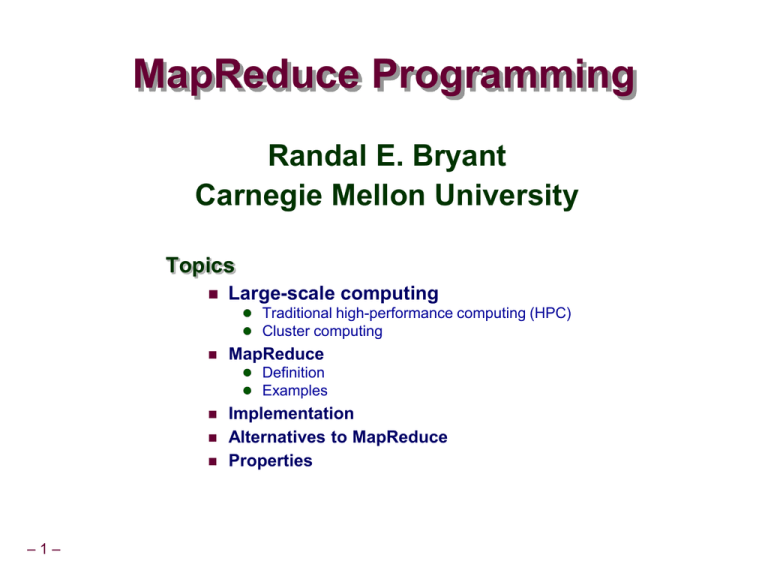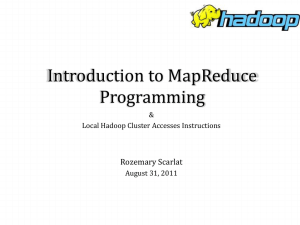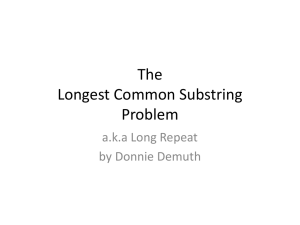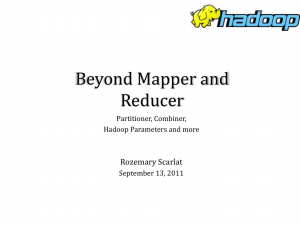MapReduce Programming Randal E. Bryant Carnegie Mellon University Topics
advertisement

MapReduce Programming
Randal E. Bryant
Carnegie Mellon University
Topics
Large-scale computing
Traditional high-performance computing (HPC)
Cluster computing
MapReduce
Definition
Examples
–1–
Implementation
Alternatives to MapReduce
Properties
Typical High Performance Computing
Machine
Compute Nodes
Compute Nodes
CPU
CPU
Mem
Mem
•••
CPU
Mem
Network
Network
High end
processor(s)
Lots of RAM
Specialized
Very high
performance
Storage Server
•••
Storage Server
–2–
RAID-based disk
array
HPC Machine Example
Jaguar Supercomputer
6th fastest in world
Compute Nodes
18,688 node
Node
2X 2.6Ghz 6-core AMD Opteron
16GB memory
Combined total
2.3 petaflop / 300 TB memory
5.1 MW total power consumption
Network
3D torus
Each node connected to 6 neighbors via 6.0 GB/s links
Storage Server
– 3 –
10PB RAID-based disk array
HPC Programming Model
Application
Programs
Software
Packages
Machine-Dependent
Programming Model
Hardware
Programs described at very low level
Specify detailed control of processing & communications
Rely on small number of software packages
Written by specialists
Limits classes of problems & solution methods
–4–
Bulk Synchronous Programming
Solving Problem Over Grid
E.g., finite-element
computation
Partition into Regions
p regions for p processors
Map Region per Processor
–5–
Local computation sequential
Periodically communicate
boundary values with
neighbors
Typical HPC Operation
Characteristics
Message Passing
P1
P2
P3
P4
P5
Long-lived processes
Make use of spatial locality
Hold all program data in
memory (no disk access)
High bandwidth
communication
Strengths
High utilization of resources
Effective for many scientific
applications
Weaknesses
–6–
Requires careful tuning of
application to resources
Intolerant of any variability
P1
P2
P3
P4
Checkpoint
P5
HPC Fault Tolerance
Checkpoint
Wasted
Computation
Restore
Restore
Checkpoint
Periodically store state of all
processes
Significant I/O traffic
When failure occurs
Reset state to that of last
checkpoint
All intervening computation
wasted
Performance Scaling
–7–
Very sensitive to number of
failing components
Examples of Big Data Sources
Wal-Mart
267 million items/day, sold at 6,000 stores
HP built them 4 PB data warehouse
Mine data to manage supply chain,
understand market trends, formulate
pricing strategies
LSST
–8–
Chilean telescope will scan entire sky
every 3 days
A 3.2 gigapixel digital camera
Generate 30 TB/day of image data
Google Data Centers
Dalles, Oregon
Hydroelectric power @ 2¢ /
KW Hr
50 Megawatts
Enough to power 60,000 homes
–9–
Engineered for maximum
modularity & power efficiency
Container: 1160 servers,
250KW
Server: 2 disks, 2 processors
Typical Cluster Machine
Compute + Storage Nodes
Compute + Storage
Nodes
CPU
CPU
Mem
Mem
•••
CPU
Mem
Mediumperformance
processors
Modest memory
1-2 disks
Network
Network
Conventional
Ethernet switches
10 Gb/s within rack
100 Gb/s across
racks
– 10 –
Machines with Disks
Lots of storage for
cheap
Seagate Barracuda
3 TB @ $130
(4.3¢ / GB)
Compare 2007:
0.75 TB @ $266
35¢ / GB
Drawbacks
Long and highly variable
delays
Not very reliable
Not included in HPC
Nodes
– 11 –
Oceans of Data, Skinny Pipes
1 Terabyte
– 12 –
Easy to store
Hard to move
Disks
MB / s
Time
Seagate Barracuda
115
2.3 hours
Seagate Cheetah
125
2.2 hours
Networks
MB / s
Time
Home Internet
< 0.625
> 18.5 days
Gigabit Ethernet
< 125
> 2.2 hours
PSC Teragrid
Connection
< 3,750
> 4.4 minutes
Data-Intensive System Challenge
For Computation That Accesses 1 TB in 5 minutes
Data distributed over 100+ disks
Assuming uniform data partitioning
Compute using 100+ processors
Connected by gigabit Ethernet (or equivalent)
System Requirements
Lots of disks
Lots of processors
Located in close proximity
Within reach of fast, local-area network
– 13 –
Ideal Cluster Programming Model
Application
Programs
Machine-Independent
Programming Model
Runtime
System
Hardware
– 14 –
Application programs written in terms of high-level operations on data
Runtime system controls scheduling, load balancing, …
Map/Reduce Programming Model
k1
k1
kr
Reduce
Key-Value
Pairs
M
M
M
x1
x2
x3
M
Map
xn
Map computation across many objects
E.g., 1010 Internet web pages
– 15 –
Aggregate results in many different ways
System deals with issues of resource allocation & reliability
Dean & Ghemawat: “MapReduce: Simplified Data
Processing on Large Clusters”, OSDI 2004
MapReduce Example
Come,
Dick
– 16 –
Come
and
see.
Come,
come.
Come
and
see.
Come
and
see
Spot.
Create an word index of set of documents
MapReduce Example
1
3
dick
6
and
come
dick, 1
1
see
come, 1
come, 1
come, 1
and, 1 see, 1
see, 1
come, 1
come, 2 and, 1
Sum
spot
spot, 1
M
M
M
M
Come,
Dick
Come
and
see.
Come,
come.
Come
and
see.
Come
and
see
Spot.
Word-Count
Pairs
and, 1
M
– 17 –
3
Extract
Map: generate word, count pairs for all words in document
Reduce: sum word counts across documents
Hadoop Project
File system with files distributed across nodes
Local Network
CPU
CPU
CPU
Node 1
Node 2
Node n
Store multiple (typically 3 copies of each file)
If one node fails, data still available
Logically, any node has access to any file
May need to fetch across network
Map / Reduce programming environment
– 18 –
Software manages execution of tasks on nodes
Hadoop MapReduce API
Requirements
Programmer must supply Mapper & Reducer classes
Mapper
Steps through file one line at a time
Code generates sequence of <key, value> pairs
Call output.collect(key, value)
Default types for keys & values are strings
Lots of low-level machinery to convert to & from other data types
But can use anything “writable”
Reducer
Given key + iterator that generates sequence of values
Generate one or more <key, value> pairs
Call output.collect(key, value)
– 19 –
Hadoop Word Count Mapper
public class WordCountMapper extends MapReduceBase
implements Mapper {
private final static Text word = new Text();
private final static IntWritable count = new IntWritable(1);
public void map(WritableComparable key, Writable values,
OutputCollector output, Reporter reporter)
throws IOException {
/* Get line from file */
String line = values.toString();
/* Split into tokens */
StringTokenizer itr = new StringTokenizer(line.toLowerCase(),
" \t.!?:()[],'&-;|0123456789");
while(itr.hasMoreTokens()) {
word.set(itr.nextToken());
/* Emit <token,1> as key + value
output.collect(word, count);
}
}
}
– 20 –
Hadoop Word Count Reducer
public class WordCountReducer extends MapReduceBase
implements Reducer {
public void reduce(WritableComparable key, Iterator values,
OutputCollector output, Reporter reporter)
throws IOException {
int cnt = 0;
while(values.hasNext()) {
IntWritable ival = (IntWritable) values.next();
cnt += ival.get();
}
output.collect(key, new IntWritable(cnt));
}
}
– 21 –
MapReduce Implementation
Built on Top of Parallel File System
Google: GFS, Hadoop: HDFS
Provides global naming
Reliability via replication (typically 3 copies)
Breaks work into tasks
Master schedules tasks on workers dynamically
Typically #tasks >> #processors
Net Effect
– 22 –
Input: Set of files in reliable file system
Output: Set of files in reliable file system
MapReduce Execution
R Output Files
Reducer
Reducer
Reducer
R Reducers
Shuffle
Task
Manager
– 23 –
Mapper
Mapper
Mapper
Input Files (Partitioned into Blocks)
M Mappers
Mapping
h
K
h(K) Î {0,..., R -1}
Hash Function h
Maps each key K to integer i
such that 0 ≤ i < R
Mapper Operation
– 24 –
Reads input file blocks
Generates pairs K, V
Writes to local file h(K)
Local
Files
Mapping
R local files
per mapper
Mapper
Dynamically map input file blocks onto mappers
Each generates key/value pairs from its blocks
Each writes R files on local file system
Mapper
Mapper
Task
Manager
– 25 –
Input Files (Partitioned into Blocks)
M Mappers
Shuffling
Each Reducer:
Reducer
MXR
local files
– 26 –
Handles 1/R of the possible key values
Fetches its file from each of M mappers
Sorts all of its entries to group values by keys
Reducer
Reducer
R Reducers
Reducing
Each Reducer:
Executes reducer function for each key
Writes output values to parallel file system
R Output Files
Reducer
– 27 –
Reducer
Reducer
R Reducers
MapReduce Effect
R Output Files
MapReduce
Input Files (Partitioned into Blocks)
MapReduce Step
– 28 –
Reads set of files from file system
Generates new set of files
Can iterate to do more complex processing
Map/Reduce Operation Summary
Characteristics
Map/Reduce
Map
Mapping, reducing
Reduce
Map
Reduce
Map
Reduce
Map
Computation broken into
many, short-lived tasks
Use disk storage to hold
intermediate results
Strengths
Reduce
Great flexibility in placement,
scheduling, and load
balancing
Can access large data sets
Weaknesses
– 29 –
Higher overhead
Lower raw performance
Map/Reduce Fault Tolerance
Data Integrity
Map/Reduce
Map
Reduce
Map
Reduce
Map
Reduce
Map
Continuous checkpointing
Recovering from Failure
Simply recompute lost result
Localized effect
Reduce
– 30 –
Store multiple copies of each
file
Including intermediate
results of each Map / Reduce
Dynamic scheduler keeps all
processors busy
Interesting Features
Fault Tolerance
Assume reliable file system
Detect failed worker
Heartbeat mechanism
Reschedule failed task
Stragglers
Tasks that take long time to execute
Might be bug, flaky hardware, or poor partitioning
When done with most tasks, reschedule any remaining
executing tasks
Keep track of redundant executions
Significantly reduces overall run time
– 31 –
Cluster Scalability Advantages
Distributed system design principles lead to scalable design
Dynamically scheduled tasks with state held in replicated files
Provisioning Advantages
Can use consumer-grade components
maximizes cost-peformance
Can have heterogenous nodes
More efficient technology refresh
Operational Advantages
– 32 –
Minimal staffing
No downtime
Exploring Parallel Computation Models
Map/Reduce
MPI
SETI@home
Threads
Low Communication
Coarse-Grained
High Communication
Fine-Grained
Map/Reduce Provides Coarse-Grained Parallelism
Computation done by independent processes
File-based communication
Observations
– 33 –
PRAM
Relatively “natural” programming model
Research issue to explore full potential and limits
Beyond Map/Reduce
Typical Map/Reduce Applications
Sequence of steps, each requiring map & reduce
Series of data transformations
Iterating until reach convergence
Strengths of Map/Reduce
User writes simple functions, system manages complexities
of mapping, synchronization, fault tolerance
Very general
Good for large-scale data analysis
Limitations
– 34 –
No locality of data or activity
Each map/reduce step must complete before next begins
Generalizing Map/Reduce
Microsoft Dryad Project
Computational Model
Acyclic graph of operators
Opk
Opk
Opk
Opk
But expressed as textual program
Each takes collection of objects and
produces objects
Purely functional model
Implementation Concepts
– 35 –
Objects stored in files or memory
Any object may be lost; any
operator may fail
Replicate & recompute for fault
tolerance
Dynamic scheduling
# Operators >> # Processors
Op2
Op2
Op2
Op2
Op1
Op1
Op1
Op1
x1
x2
x3
xn
CMU GraphLab
Carlos Guestrin, et al.
Graph algorithms used in machine learning
View Computation as Localized Updates on Graph
– 36 –
New value depends on own value + those of neighbors
Update repeatedly until converge
Machine Learning Example
PageRank Computation
Larry Page & Sergey Brinn, 1998
Rank “Importance” of Web Pages
1.20
0.79
1.51
0.42
1.16
0.78
1.14
– 37 –
PageRank Computation
Initially
R2
Assign weight 1.0 to each page
R3
Iteratively
Select arbitrary node and update
its value
R1
Convergence
Results unique, regardless of
selection ordering
R5
R1 0.1 + 0.9 * (½ R2 + ¼ R3 + ⅓ R5)
– 38 –
PageRank with Map/Reduce
R1 0.1 + 0.9 * (½ R2 + ¼ R3 + ⅓ R5)
Each Iteration: Update all nodes
Map: Generate values to pass along each edge
Key value 1: (1, ½ R2)
(1, ¼ R3)
(1, ⅓ R5)
Similar for all other keys
Reduce: Combine edge values to get new rank
R1 0.1 + 0.9 * (½ R2 + ¼ R3 + ⅓ R5)
Similar for all other nodes
Performance
Very slow!
Altavista Webgraph 2002
1.4B vertices, 6.7B edges
Hadoop
– 39 –
800 cores
9000s
PageRank with GraphLab
Operation
Graph partitioned across multiple processors
Each doing updates to its portion of graph
Exploits locality
Greater asynchrony
Only iterate over portions of graph where values are changing
Performance
Altavista Webgraph 2002
1.4B vertices, 6.7B edges
Hadoop
800 cores
Prototype GraphLab2 512 cores
– 40 –
9000s
431s
Conclusions
Distributed Systems Concepts Lead to Scalable
Machines
Loosely coupled execution model
Lowers cost of procurement & operation
Map/Reduce Gaining Widespread Use
Hadoop makes it widely available
Great for some applications, good enough for many others
Lots of Work to be Done
Richer set of programming models and implementations
Expanding range of applicability
Problems that are data and compute intensive
The future of supercomputing?
– 41 –





